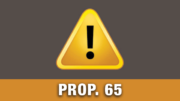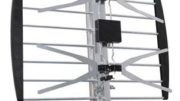Want to know a secret? I, the guy who gets about two dozen antennas to review every year, relies on a 54-year-old antenna for daily use. It’s the one you see above, an old Channel Master model that’s been up there serving faithfully for half a decade.
If you live in a home built before 1980, you might have an old antenna up on your roof too. It might be in perfect shape. But how can you know? As much as I would love to sell you an antenna from the great selection we have at Solid Signal, I wouldn’t feel right selling you an antenna if you didn’t need one. So, let’s talk about what separates a good antenna from a bad one.
First question: overall condition
Most antennas you see on old houses look similar to the one on my house. They’re vaguely arrow shaped with various metal bits coming off in different directions. The narrowest part should be pointing toward a major city in most cases. These are called yagi or hybrid yagi-log periodic antennas and they were absolutely the best choice in the 1950s through 1970s. They pick up all the channels from 2-36 and can even pick up frequencies that used to be on channels 37-83. Those channels don’t exist anymore, by the way.
Take a look at the antenna. Are the metal elements droopy or do they seem bent or broken? Does it seem like something is missing? These are indications of an antenna that needs to be replaced. The only way to build antennas back then was to make them as tough as Mack trucks, so a lot of them have held up really well over the years. Some haven’t. Those antennas will need replacement.
Don’t worry about a layer of black dust on the antenna. This is called oxidation. It’s a natural part of leaving aluminum outside. It doesn’t affect reception.
Second question: the cable
Most old antennas use twin-lead flat cable. You can still get this cable. In many cases it’s actually superior to the coax cable we use today. But you should inspect the cable for rot, cuts, bends or breaks. If you do choose to replace the cable, you can use the newer coaxial cable by using a matching transformer like this one. If you’re able to salvage some of the flat cable, you can use one like this to convert it to coaxial. Unless the flat cable is in good shape, it should probably be replaced. The weather can do a number on it after 50ish years.
Third question: the aim
The old analog televisions sometimes needed special aiming in order to get all the channels you needed. Aiming straight at the towers sometimes gave you too much signal. Sometimes there was weird interference due the signal bouncing off something. As a result, homeowners sometimes aimed their antennas in weird ways.
You can connect up the antenna and see if you’re getting the channels you need. Generally you will need to go into the TV’s menus and scan for channels. The technique is different for every model TV. I’d recommend Googling the owners’ manual since you probably tossed the printed one the day you got it.
If you’re not getting the channels you want, try re-aiming the antenna straight at the closest large city. This will generally help.
If you’ve determined it’s time for a new antenna…
…that’s ok. These things happen. Nothing lasts forever. There are hundreds of new models, including ones that are smaller and cooler looking, all at SolidSignal.com. If you don’t know what you need, call us! The number is 888-233-7563. We’re here during East Coast business hours. When you call, you’ll get a real technician who knows what they’re talking about and can help you with all your questions.





